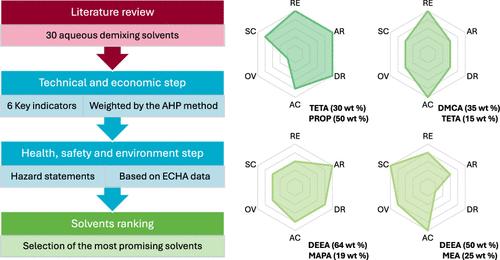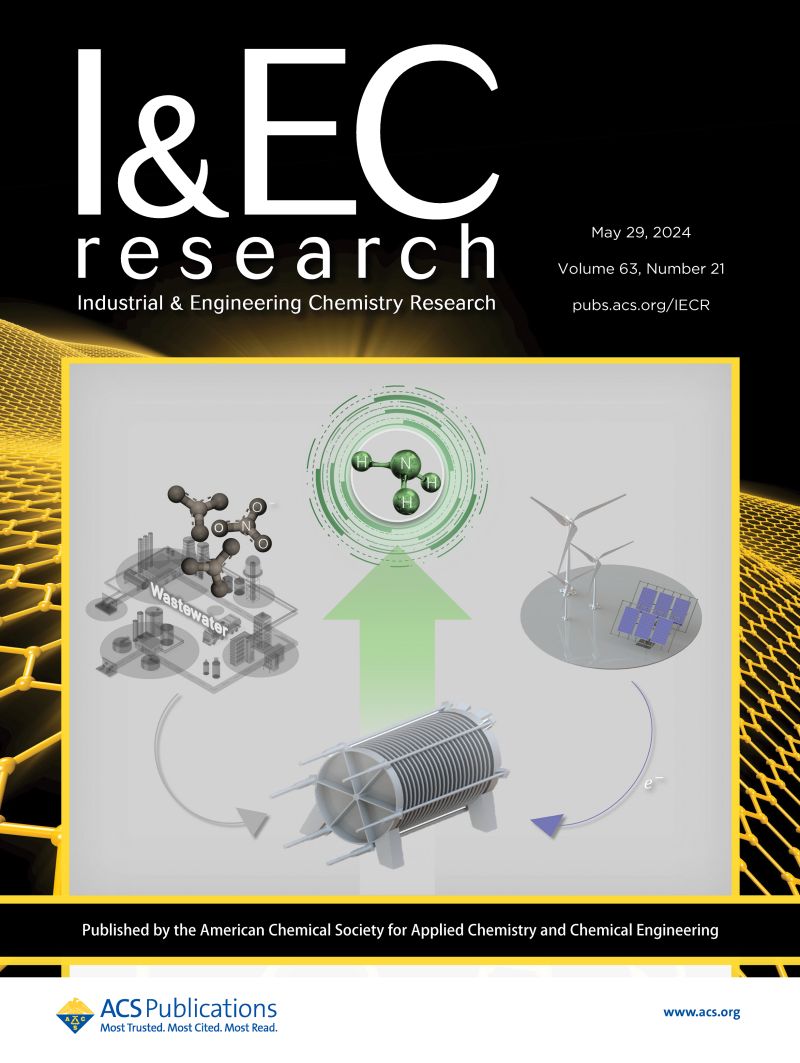Methodological Selection of Demixing Liquid–Liquid Solvents Used in the Absorption–Regeneration Carbon Capture Process
IF 3.9
3区 工程技术
Q2 ENGINEERING, CHEMICAL
引用次数: 0
Abstract
Since the 19th century, the carbon dioxide concentration in the atmosphere has never been so high due to anthropogenic emissions. This increase in the greenhouse gas concentrations in the atmosphere has been identified as the main cause of global warming. The absorption–regeneration postcombustion carbon capture technology has the highest Technology Readiness Level (TRL) to limit the CO2 emissions. Nevertheless, the type of process is a high consumer of thermal energy to regenerate the liquid solvent used to absorb carbon dioxide. A solution to reduce this high energy demand is the use of liquid–liquid biphasic (or demixing) solvents that have the capacity to split into two phases under certain conditions of temperature and CO2 loading. The present work aims to classify the aqueous liquid–liquid biphasic solvents after a literature review of the existing solvents to determine the most promising ones for further investigations. This methodology is composed of two successive steps. The first step is based on six technoeconomic indicators: the regeneration energy, the CO2 absorption capacity, the CO2 absorption rate, the volume ratio between the two phases, the volatility of organic compounds, and the solvent cost. The contribution of each key indicator is weighted using the analytical hierarchy process method. The result of this first step is the ranking of the 30 solvents identified in the literature. The second step is a Health, Safety, and Environment (HSE) analysis. It excludes 17 solvents containing at least one molecule that presents a serious hazard for human life or the environment. After the application of this methodological evaluation, the final results show that the three most promising aqueous biphasic solvents are, respectively, composed of triethylenetetramine (30 wt %) and propan-1-ol (50 wt %), N,N-dimethylcyclohexylamine (35 wt %) and triethylenetetramine (15 wt %), and diethylethanolamine (64 wt %) and methylaminopropylamine (19 wt %).

吸收-再生碳捕集工艺中分离液-液溶剂的方法学选择
自19世纪以来,由于人为排放,大气中的二氧化碳浓度从未如此之高。大气中温室气体浓度的增加已被确定为全球变暖的主要原因。燃烧后碳捕获技术具有最高的技术准备水平(TRL)来限制二氧化碳的排放。然而,这类工艺需要大量的热能来再生用于吸收二氧化碳的液体溶剂。减少这种高能量需求的一个解决方案是使用液-液双相(或脱混)溶剂,这种溶剂在一定的温度和二氧化碳负荷条件下能够分裂成两相。在对现有溶剂进行文献综述的基础上,对水-液双相溶剂进行分类,以确定最有前途的溶剂。这种方法由两个连续的步骤组成。第一步是基于六个技术经济指标:再生能量、CO2吸收能力、CO2吸收率、两相体积比、有机化合物挥发性和溶剂成本。采用层次分析法对各关键指标的贡献进行加权。这第一步的结果是在文献中确定的30种溶剂的排名。第二步是健康、安全和环境(HSE)分析。它不包括含有至少一种对人类生命或环境构成严重危害的分子的17种溶剂。应用该方法评价后,最终结果表明,三种最有前途的双相水溶剂分别由三乙基四胺(30 wt %)和丙烯-1醇(50 wt %)、N,N-二甲基环己胺(35 wt %)和三乙基四胺(15 wt %)、二乙基乙醇胺(64 wt %)和甲氨基丙胺(19 wt %)组成。
本文章由计算机程序翻译,如有差异,请以英文原文为准。
求助全文
约1分钟内获得全文
求助全文
来源期刊

Industrial & Engineering Chemistry Research
工程技术-工程:化工
CiteScore
7.40
自引率
7.10%
发文量
1467
审稿时长
2.8 months
期刊介绍:
ndustrial & Engineering Chemistry, with variations in title and format, has been published since 1909 by the American Chemical Society. Industrial & Engineering Chemistry Research is a weekly publication that reports industrial and academic research in the broad fields of applied chemistry and chemical engineering with special focus on fundamentals, processes, and products.
 求助内容:
求助内容: 应助结果提醒方式:
应助结果提醒方式:


